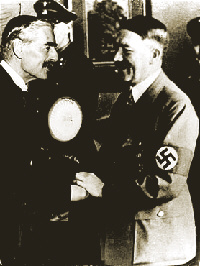
|
||||||||
 Pvt. Henry Tandey, VC at Marcoing |
||||||||
 Pvt. Tandy |
Tandey was mentioned five times in dispatches and certainly earned his VC during the capture of the French village and crossing at Marcoing, his regiment held down by heavy machine gun fire Tandey crawled forward, located the machine gun nest and took it out. Arriving at the crossing he braved heavy fire to place wooden planks over a gaping hole enabling troops to roll across and take the battle to the Germans, the day still not over he successfully led a bayonet charge against outnumbering enemy troops which helped bring hostilities to an end. As the ferocious battle wound down and enemy troops surrendered or retreated a wounded German soldier limped out of the maelstrom and into Private Tandey's line of fire, the battle weary man never raised his rifle and just stared at Tandey resigned to the inevitable. "I took aim but couldn't shoot a wounded man," said Tandey, "so I let him go." [2]
The young German soldier nodded in thanks and the two men took diverging paths, that day and in history. Hitler retreated with the remnants of German troops and ended up in Germany, where he languished in the humiliation of defeat at wars end. Tandey put that encounter out of his mind and rejoined his regiment, discovering soon after he had won the Victoria Cross. It was announced in the London Gazette on 14th December 1918 and he was personally decorated by King George V at Buckingham Palace on 17th December 1919, in newspaper reports a picture of him carrying a wounded soldier after the Battle of Ypres was published, a dramatic image which symbolized a war which was supposed to have put an end to all wars and immortalized on canvas by Italian artist Fortunino Matania.
Leaving the army in 1926 at the rank of sergeant the 35 year old settled in Leamington where he married, settling back into civilian life he spent the next 38 years as Commissionaire, or plant security chief, at Triumph, then called the Standard Motor Company. He lived a quiet life and although regarded as a hero by all and sundry wasn't one to brag or boast, wouldn't mention the war unless asked about it.
In 1938 Prime Minister Neville Chamberlain (1869-1940), Conservative PM from 1937-40, made his gloomy trip to Munich to meet Chancellor Hitler in a last ditched effort to avoid war which resulted in the ill-fated 'Munich Agreement'. During that fateful trip Hitler invited him to his newly completed retreat in Berchtesgaden, Bavaria, a birthday present from Martin Bormann and the NAZI Party. Perched 6017 feet up on Kehlstein Mountain it commanded spectacular views for 200 kilometers in all directions. While there the Prime Minister explored the hill top lair of the Führer and found a reproduction of Matania's famous Marcoing painting depicting allied troops, puzzled by the choice of art Hitler explained, "that man came so near to killing me that I thought I should never see Germany again, providence saved me from such devilishly accurate fire as those English boys were aiming at us". [2]
 Chamberlain with Hitler |
The story first broke in 1940 but no one gave it much thought at the time, however in recent years it has generated greater interest. Some historians are doubtful as it sounds too good to be true, however it has an unmistakable ring of truth to it. No one in their right mind would make up a story about having spared the life of a tyrant who at that time had just fire bombed Coventry, was Blitzing London and mass murdering people on the continent. Hitler's regiment was in the Marcoing region at the time although his presence cannot be verified, a great deal of German records for the Great War were lost in WWII due to allied bombing of Berlin which resulted in the destruction of a significant amount of the State Archives. So documents showing Adolph Hitler's exact whereabouts on 28 September 1918 are not available, Hitler biographers have differing opinions. However there is irrefutable evidence that Hitler possessed a copy of the famous Matania painting featuring Tandey as early as 1937, acquiring it from Tandey's old regiment. "Colonel Earle said that he had heard from one Dr. Schwend that Hitler had expressed a wish to have a large photograph of the Matania painting. Obviously one was sent because Captain Weidmann, Hitler's Adjutant, wrote the following to Earle:
'I beg to acknowledge your friendly gift which has been sent to Berlin through the good offices of Dr. Schwend. The Fuhrer is naturally very interested in things connected with his own war experiences, and he was obviously moved when I showed him the picture and explained the thought which you had in causing it to be sent to him. He has directed me to send you his best thanks for your friendly gift which is so rich in memories.' [3]
The Tandey family were in no doubt of the story's authenticity, they were present when Prime Minister Chamberlain phoned, "Tandey's nephew, William Whateley, from Thomaby, calls to mind a mysterious phone call almost 60 years ago, when the storm clouds of war were brewing and Prime Minister Chamberlain was futilely appeasing Herr Hitler. One evening the telephone rang and Henry went off to answer it, when he came back he commented matter-of-factly that it had been Mr Chamberlain. He had just returned from a meeting with Hitler and whilst at Berchtesgaden had noticed the painting by Matania of the 2nd Green Howards at the Menin Cross Roads in 1914. Chamberlain had asked what it was doing there and in reply Hitler had pointed out Tandy in the foreground and commented, "that's the man who nearly shot me" [4]
One crucial aspect of the event which historians have overlooked is the fact that Adolph Hitler and Henry Tandy both fought at the Battle of Ypres in 1914, a far more significant event in the life of Hitler. He distinguished himself in combat several times and saved the life of a seriously wounded officer, his heroism resulted in him being promoted to Lance Corporal. The famous picture by Matania depicting Tandy carrying a wounded comrade to the first aid station at the Menin Cross Roads was painted based on that battle not Marcoing. It's possible that places got mixed up, it may well have been Ypres not Marcoing where Hitler and Tandey crossed paths and parted on amicable terms. Tandey told a journalist that during the Great War he had as a rule spared wounded and disarmed German soldiers, so Marcoing wasn't the first or last time he performed a humane deed in inhumane circumstances. The fact he was awarded the illustrious VC for heroic deeds at Marcoing may have affected Prime Minister Chamberlains recollections of Hitler's war story, which may have included Tandey's having won the VC at Marcoing, a fact which would have undoubtedly impressed Hitler. One thing which is clear and certain is that there must have been some significant connection between Hitler and the Fortunino Matania painting featuring Tandey, the Führer of the demonic Third Reich wasn't a collector of British wartime iconography and if he wanted propaganda images of the Battle of Ypres he would have chosen one in which the German not the enemy troops were depicted as valiant heroes.

Click here to read a summary of Hitler's war service.
Tandey was haunted the remainder of his life by his good deed, the simple squeeze of a trigger would have spared the world a catastrophe which cost tens of millions of lives. He was living in Coventry when the Luftwaffe destroyed the city in 1940, sheltered in a doorway as the building he was in crumbled and city burned like a scene from Dante's Inferno. He was also in London during the Blitz and experienced that atrocity first hand, he told a journalist in 1940, "if only I had known what he would turn out to be. When I saw all the people, woman and children he had killed and wounded I was sorry to God I let him go". [2]
When war irrupted the 49 year old tried to rejoin his regiment to see to it that, "he didn't escape a second time", [2] but failed the physical due to wounds received at the Battle of the Somme. Nonetheless he did his bit on the homefront, volunteering wherever he could be of service but was always haunted by an act of decency to an indecent man. Henry Tandey VC DCM MM died without issue in Coventry in 1977 aged 86, in accordance with his wishes he was cremated and interred at the British Cemetery in Marcoing alongside fallen comrades and close to where he won his Victoria Cross 60 years earlier. His widow sold his medals three years later for a record £27.000 and on Armistice Day 1997 they were presented to his old regiment, the Green Howards, by Sir Ernest Harrison OBE at a special ceremony at the Tower of London and are displayed with great pride at the Green Howards regimental museum.
References:
- Beyond Their Duty, by Roger Chapman.
- Sunday Graphic, Coventry, UK. December 1940.
- Colonel Earle, The Green Howards Gazette, UK. June. 1937.
- The Evening Gazette, Middlesbrough. UK.
Sources:
- The Green Howards. Alexandra, Princess of Wales's Own Yorkshire Regiment. The 19th Regiment of Foot. By whose grace Tandey related images are reproduced.
- Mr. Edward McKillop Nicholl.
- The Berchtesgaden Tourist Board.
- The International Express.
Credits and Thanks. Contact the author, John Godl at: archive@collector.org

Great War return to the Contents Page |
Membership Information  Click on Icon |
|
The Great War Society | ||
Additions and comments on these pages may be directed to: Michael E. Hanlon (medwardh@hotmail.com) regarding content, or to Mike Iavarone (mikei01@execpc.com) regarding form and function. Original artwork & copy; © 1998-2001, TGWS. | ||
